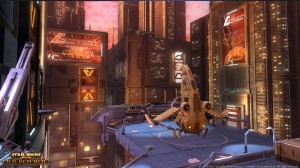 This week Star Wars: The Old Republic gives us a Studio Insider: Environment Polish with Senior Environment Artist Robby Lamb. Also included in the update is a very nice Community Q&A. Lamb starts with talking about how important polish is to a game especially a MMO, and how it can turn a great game into an exceptional one. Polishing is pretty much the process of re-working and tweaking of something the design team or programmers have already made for the game, such as lighting, walls, floor, or anything that needs a touch up.
This week Star Wars: The Old Republic gives us a Studio Insider: Environment Polish with Senior Environment Artist Robby Lamb. Also included in the update is a very nice Community Q&A. Lamb starts with talking about how important polish is to a game especially a MMO, and how it can turn a great game into an exceptional one. Polishing is pretty much the process of re-working and tweaking of something the design team or programmers have already made for the game, such as lighting, walls, floor, or anything that needs a touch up.
Every member of the development team polishes the game in a different way. For example, programmers will optimize code which helps in various ways, such as the frame rate and the lighting engine. While improving the game, those code optimizations can also help the other developers who are using game development tools; this gives designers the chance to polish game play. Artists like myself have the opportunity to revisit areas to re-work assets, adjust lighting or just ensure an area feels true enough to our story.
Lamb goes on to tell us about how environment in MMOs can go unnoticed, until something is wrong or seems out of place then it becomes an eyesore for players. Lamb uses walls in The Old Republic as an example of this. Some of you might think walls would be easy to create, eh? Well apparently they are not. Walls under go a lot of polish turning from basic walls with simple texture to being reworked several times to help tell the visual story of the game. Sometimes the walls need to be made to look more high tech or or more detailed than the standard panel style wall. Another form of polishing that Robby Lamb works with is re-lighting and dding of props to an area, all of which go back to the helping of the visual story. The original process begins with a description of a room or place, given by the writers and game designers, Lamb uses a computer lab as an example. The computer lab will begin it’s existence in the most simple form likely a room full of computers, desks, possibly book shelves, and a few NPCs. Lamb gives a great description of how it can change, he says “However later in development a more detailed description may evolve – describing this area as a computer lab, locked from the outside, with a hacker trapped inside who is enslaved to the Empire. Based on this description we will go back into an area and address it by either building new or reusing more appropriate assets to fit the scene, relighting the area, as well as adjusting the environment settings such as fog depth or color.”
Finally, Lamb goes over one of the more important parts of environmental polish: game performance. Most people wouldn’t associate the two but really you gotta remember that your machine has to load everything from other players’ character models, NPCs, the environment, and the lighting. So after all the visual polish is done in an area the team then checks how many lights and assets are on screen and how much memory the level uses as a whole to help keep the almighty frame rate up.


Recent Comments